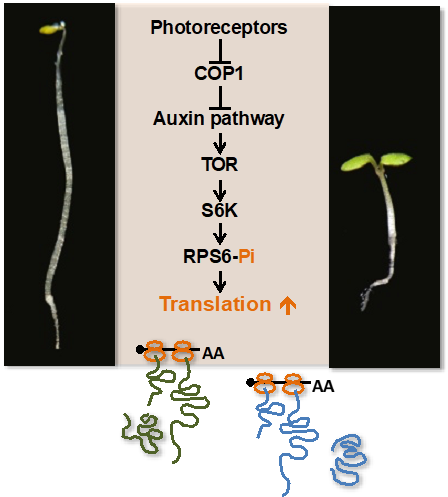[Shu-Hsing Wu] Target of rapamycin (TOR) and ribosomal protein S6 (RPS6) transmit light signals to enhance protein translation in de-etiolating Arabidopsis seedlings
POST:Plants are capable of transforming sunlight energy to chemical energy stored in carbohydrates. The presence or absence of light also serves as important environmental cues for plants to deploy appropriate developmental programs for coping with the environment. Photomorphogenesis is an essential developmental process transforming young plant seedlings into the vegetative phase with photosynthetic activities. Despite the abundant knowledge of transcriptional and post-translational regulation in photomorphogenesis, translational control by light signals is much less discussed. We previously showed that light activates the translation of thousands of mRNAs in de-etiolating seedlings. What remains to be revealed is the underlying molecular mechanism responsible for the massive translation triggered by light signals in de-etiolating Arabidopsis seedlings.
We showed that light-enhanced translation is orchestrated by a light perception and signaling pathway composed of photoreceptors, CONSTITUTIVE PHOTOMORPHOGENESIS 1 (COP1), the phytohormone auxin, target of rapamycin (TOR) and ribosomal protein S6 (RPS6). In de-etiolating Arabidopsis seedlings, photoreceptors including phytochrome A and cryptochromes perceive far-red and blue light to inactivate the negative regulator COP1, which leads to activation of the auxin pathway for TOR-dependent phosphorylation of RPS6. Arabidopsis mutants defective in TOR, RPS6A or RPS6B exhibited delayed cotyledon opening, a characteristic of the de-etiolating process to ensure timely vegetative development of a young seedling. This study provides a mechanistic view of light-triggered translational enhancement in de-etiolating Arabidopsis. This sophisticated regulation also functions to ensure that young seedlings have strict skotomorphogenic development in the dark and a timely switch to photomorphogenic development. (Chen et al, PNAS 2018)
